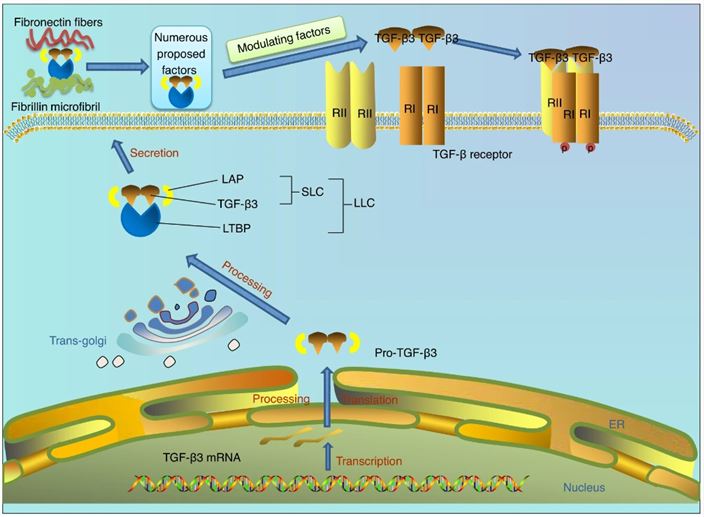What is TGFB3 Protein
In the intricate landscape of molecular biology, one protein that has been gaining increasing attention is the transforming growth factor beta 3 (TGFB3) protein. This multifaceted molecule plays a crucial role in various physiological processes, and its implications in health and disease are becoming clearer as research progresses.
Encoded by the TGFB3 gene, this homodimeric polypeptide belongs to the transforming growth factor beta (TGF-β) family, which comprises three isoforms—TGF-β1, TGF-β2, and TGF-β3. TGFB3, specifically, is the architect behind TGF-β3, a protein with pivotal roles in cellular processes.
 Figure 1. The synthesis, proteolytic processing, secretion and activation of TGF-β3. (Du, X., et al. 2023)
Figure 1. The synthesis, proteolytic processing, secretion and activation of TGF-β3. (Du, X., et al. 2023)The Function of TGFB3 Protein
TGFB3 emerges as a linchpin in embryonic development, orchestrating critical processes such as cell differentiation, tissue patterning, and organogenesis. The protein's fingerprints are particularly evident in the formation of structures like the palate, limbs, and heart. Its multi-faceted influence extends to immune regulation, where TGFB3 modulates immune responses, showcasing its dual functionality in development and immune system equilibrium.
TGFB3-Related Diseases
TGFB3 mutations have been implicated in cleft palate, an impactful congenital anomaly. The failure of the palate to close during fetal development, attributed to TGFB3 gene mutations, underscores the protein's indispensable role in palate formation. Beyond this, TGFB3's involvement in fibrotic disorders, including pulmonary and liver fibrosis, adds layers to its significance in disease pathology.
TGFB3 Related Signaling Pathways
As TGFB3 engages its cell surface receptors, a cascade of events commences. Intracellular signaling molecules are activated, culminating in the regulation of gene expression. This intricate pathway, tightly regulated to ensure cellular homeostasis, becomes a focal point in understanding diseases linked to TGFB3 dysregulation, such as cancer, autoimmune diseases, and fibrosis.
Applications of TGFB3 in Biomedical Research
- Tissue Engineering and Regenerative Medicine
In the realm of regenerative medicine, TGFB3 emerges as a promising protagonist. Its role in tissue development and repair positions it as a potential catalyst for enhanced regeneration of damaged tissues. Researchers are exploring ways to leverage TGFB3 to promote wound healing and advance the frontiers of tissue engineering.
- Cancer Research and Therapy
The enigmatic role of TGFB3 in cancer adds a layer of complexity. While it exhibits tumor-suppressive properties in certain contexts, it may promote the progression of other tumors. Researchers are navigating this intricate balance, seeking ways to selectively modulate TGFB3 to inhibit cancer growth. The dual nature of TGFB3 in cancer provides a unique avenue for targeted therapeutic interventions.
- Immunomodulation
The immunomodulatory prowess of TGFB3 is a focus of intense exploration. Researchers are delving into ways to harness TGFB3 to manipulate immune responses for therapeutic purposes. Whether enhancing immune surveillance against cancer cells or tempering hyperactive immune reactions in autoimmune diseases, TGFB3 emerges as a potential tool for shaping the landscape of immunotherapy.
In the intricate tapestry of molecular biology, TGFB3 emerges as a protein of profound significance. Its multifaceted functions in development, immune regulation, and tissue homeostasis underscore its role as a key player in maintaining physiological balance. However, the dual nature of TGFB3, with its involvement in both health and disease, necessitates a thorough understanding of its mechanisms for targeted therapeutic interventions.
As research advances, the intricate details of TGFB3-related signal pathways and its applications in biomedicine continue to unfold. From the realm of tissue engineering to the frontiers of cancer therapy and immunomodulation, TGFB3 holds promise as a versatile tool for shaping the future of medicine. The ongoing exploration of TGFB3's mysteries not only expands our knowledge of fundamental biological processes but also paves the way for innovative approaches to tackle diseases and promote human health.
Recommended Products for TGFB3 Protein
| Cat.# | Species | Product name | Source (Host) | Tag |
|---|---|---|---|---|
| TGFB3-468H | Human | Active Recombinant Human Transforming Growth Factor, Beta 3, Dimeric Form | Nicotiana Benthamiana | N/A |
| TGFB3-2174H | Human | Active Recombinant Human TGFB3 protein, His & Avi-tagged, Biotinylated | HEK293 | His & Avi |
| TGFB3-2764H | Human | Recombinant Human TGFB3 Protein, His-tagged | E.coli | N-His |
| TGFB3-2462H | Human | Recombinant Human TGFB3 Protein, Myc/DDK-tagged, C13 and N15-labeled | HEK293T | Myc/DDK |
| TGFB3-1865HFL | Human | Recombinant Full Length Human TGFB3 Protein, C-Flag-tagged | Mammalian cells | Flag |
| Tgfb3-6390M | Mouse | Recombinant Mouse Tgfb3 Protein, Myc/DDK-tagged | HEK293T | Myc/DDK |
| TGFB3-6038R | Rat | Active Recombinant Rat Tgfb3 protein, His-tagged | E.coli | His |
| TGFB3-1254R | Rabbit | Recombinant Rabbit TGFB3 Protein, His-tagged | E.coli | N-His |
| TGFB3-245H | Human/Mouse | Active Recombinant Human/Mouse TGFB3 Protein | E.coli | |
| TGFB3-4688R | Rhesus Macaque | Recombinant Rhesus monkey TGFB3 Protein, His-tagged | Mammalian Cell | His |
Reference
- Du, X., et al. The role of TGF-beta3 in cartilage development and osteoarthritis. Bone Res. 2023, 11: 2.

